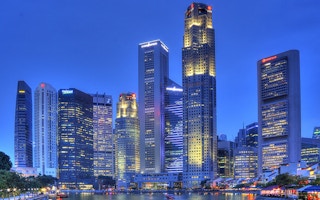Financial institutions wield tremendous influence over the global economy. It is their backing that enables companies to pursue new ventures, expand their operations, and stay afloat when profits are low. At the stroke of a pen, banks can either lead firms to success or let funding sources dry up.
With such immense power comes great responsibility. But while boosting bottom lines, the investment decisions made in the boardrooms of Asian banks have not always created long-term value for society.
From climate-killers to landgrabbers, financiers have propped up some of the world’s worst corporations, dishing out loans used to exploit vulnerable communities, raze species-rich tropical forests, and dig or drill for fossil fuels.
This needs to change, stresses a new study by Fair Finance Asia, a regional network of 25 Asian civil society organisations committed to ensuring that the funding strategies of Asian banks respect the well-being of the communities in which they operate.
The report, titled The Asian Web: Tracking Regional Financial Flows, analyses regional trends in finance going into four sectors deemed high-risk due to their potential adverse impacts on people and the environment. They include infrastructure development, power generation and agriculture as well as the extraction of oil, gas and coal.
The study focuses on the seven countries that Fair Finance Asia’s members are active in, namely Cambodia, India, Indonesia, Japan, Philippines, Thailand, and Vietnam.
It finds that there are vast credit flows crisscrossing Asia, stating that the continent’s financial interconnectedness presents opportunities for regional cooperation to foster sustainable lending activities as well as just and equitable corporate practices.
Between 2014 and 2019, banks from the seven nations surveyed provided US$556 billion in loans and underwriting services to the biggest companies by market share active in the four sectors analysed, with US$225 billion going to fossil fuel companies alone. This is in addition to more than US$118 billion that financiers invested in bonds and shares of firms from the four focus sectors.
The report was launched at the 2020 edition of Eco-Business’s flagship event Unlocking capital for sustainability on 10 September.
With clout comes responsibility
The analysis finds that regional collaboration between advocates of sustainable lending could turn the financial sector into a crucial ally in Asia’s ambition to achieve sustainable development, channelling capital into areas where it would accelerate the transition to clean energy, cultivate responsible farming practices, and advance human rights.
For instance, members of Fair Finance’s network based in India, Japan, the Philippines and Thailand—countries that are home to creditors backing Indonesian agribusiness—could jointly engage banks to push for sustainable agriculture finance in the archipelago, where ruthless palm oil companies have long wreaked havoc on forests.
Japanese lenders—found to be the largest loan providers to fossil fuel firms—could be particularly instrumental in driving responsible banking by using the subsidiaries and affiliates they have established across the region to promote the integration of environmental, social and governance (ESG) factors in financial decision-making and enhance climate disclosure requirements for corporations.
“
Since they are the ones who enable companies to do business, banks have a responsibility to ensure corporations set better standards.
Bernadette Victorio, regional programme lead, Fair Finance Asia
But measurable progress will only come with changes in policy, highlights the study. Lending guidelines must clearly reflect banks’ positions on critical issues such as global warming, environmental degradation, gender, human rights and corruption.
Governments, too, need to step up and reshape the necessary regional frameworks to more effectively address the social and environmental impacts of cross-border credit flows.
“Financial institutions and financial regulators have a big role to play in fostering the implementation of ESG standards and delivering on the UN Sustainable Development Goals (SGDs) and the Paris Agreement. It is no longer something they can ignore,” Bernadette Victorio, regional programme lead for Fair Finance Asia, told Eco-Business.
“There have to be clear policies that prevent lending to companies that violate human rights or impact the environment. Since they are the ones who enable companies to do business, banks have a responsibility to ensure corporations set better standards,” she said.
Sustainable finance on the rise
In recent years, pollution, resource scarcity, growing inequality and increasingly dire warnings of climate change have moved ESG issues into the limelight. Starting from modest levels 15 years ago, responsible financing in the world’s five major markets—Europe, the United States, Japan, Canada, and Australia and New Zealand—stood at an estimated US$30.7 trillion at the start of 2018, a 34 per cent increase in two years.
There are myriad reasons why banks should place sustainability above short-term gains, said Harjan Kuiper, chief executive officer at Rabobank Singapore and representative markets. “There is growing pressure from consumers, investors, regulators and stakeholders. That means there are real reputational and regulatory risks, especially in the digital age with the prevalence of social media.”
“
The growth of sustainable finance markets is being driven by the increasing recognition that ESG risks represent key economic risks that must be addressed.
Benjamin Cliquet, head of sustainable finance services, Vigeo Eiris
Increasingly, policymakers seek to oblige creditors to disclose the environmental and climate change implications of their lending activities. Hong Kong announced last year that it would make ESG reporting mandatory from 2021. In China, regulators are expected to make it compulsory for all listed firms and bond issuers to disclose environmental information by the end of this year.
In March 2021, the European Union’s Sustainable Finance Disclosure Regulation will also come into force, requiring asset managers to disclose how they integrate ESG factors into their investment and risk management processes.
More banks are waking up to the need to go green. In April, for instance, Mizuho—a prominent historical backer of fossil fuels and deforestation-linked industries—unveiled the strictest ESG policies of any Japanese bank to date. Under the new framework, agribusiness clients will be required to adopt No Deforestation, No Peat, No Exploitation (NDPE) policies and respect the Free Prior and Informed Consent (FPIC) of local communities.
The bank will also provide no further financing for new coal power plants and mountaintop removal, while clients involved in coal mining or oil and gas will be evaluated for their management of transition risks. Finally, all lending will be subject to prohibitions on child labour and forced labour.
“The growth of sustainable finance markets is being driven by the increasing recognition that ESG risks represent key economic risks that must be addressed,” said Benjamin Cliquet, head of sustainable finance services at ESG rating and research agency Vigeo Eiris.
“All stakeholders have to be involved in raising the capital needed to finance projects that can help economies and organisations to transition towards more sustainable business models and reach ambitious climate objectives,” he told Eco-Business.
Investment opportunities in sustainable development in Asia are as abundant as they are potentially lucrative, ranging from renewable energy and low-carbon infrastructure to waste management and clean water solutions.
The Asian Development Bank estimated in 2017 that the Asia Pacific region will require US$1.7 trillion annually until 2030 to fund the infrastructure development needed to sustain economic growth, eradicate poverty, and battle climate change.
With the global economy lying in tatters, it is perhaps surprising that the coronavirus appears to be accelerating corporate sustainability practices and ESG investing, which has seen a steady increase in inflows and better-than-average returns since the beginning of the pandemic.
Georg Kell, the chairman of Arabesque and the founding director of the United Nations Global Compact, wrote in May that the coronavirus is spurring the very forces that gave rise to ESG finance prior to the outbreak, advancing the strategic case for responsible investment.
He said the virus had thrown into stark relief the world’s reliance on digital technology as well as the need for new business models, better safety nets and health services. At the same time, Covid-19 has driven home the message that markets do not operate in isolation but are instead embedded in societies and the natural environment.
“The pandemic has heightened awareness of the close relationship between human health and the health of the planet,” Kell said. “There is no doubt that the market-led forces that propel the sustainability movement will continue to gain momentum.”





















